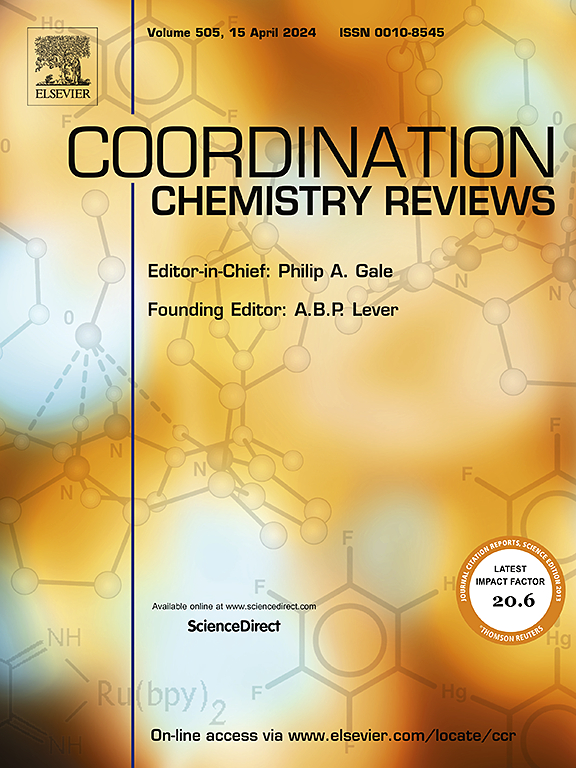挥发性有机化合物的催化氧化:负载型和非负载型催化剂的最新进展综述
IF 20.3
1区 化学
Q1 CHEMISTRY, INORGANIC & NUCLEAR
引用次数: 0
摘要
挥发性有机化合物(VOC)是一种空气污染物,因其对公众健康和环境的有害影响而备受关注。催化氧化被广泛认为是消除挥发性有机化合物的一种新兴技术,因为它不会产生二次污染物,而且所需的能源投入较低。本综述系统研究了用于 VOC 氧化的支撑贵金属催化剂(SNM)、支撑过渡金属催化剂(STM)和非支撑过渡金属氧化物(NSTM)的最新进展。首先,讨论了各种类型的挥发性有机化合物及其排放源。接着,回顾了使用 SNM、STM 和 NSTM 催化氧化不同 VOC 的最新进展。然后全面总结了 VOCs 的氧化机理。此外,还探讨了反应条件(包括 H2O、CO2、SO2、Cl 物种的存在以及反应物的组成、浓度和空间速度)对催化剂性能、失活和再生方法的影响。最后,还探讨了该领域的主要科学障碍和未来展望。本综述为今后开发和设计用于 VOC 氧化的稳定 SNM、STM 和 NSTM 催化剂奠定了坚实的实验和理论基础。本文章由计算机程序翻译,如有差异,请以英文原文为准。


Catalytic oxidation of volatile organic compounds: A review of recent advances in supported and non-supported catalysts
Volatile organic compounds (VOCs) are air pollutants that have garnered considerable consideration because of their detrimental effects on both public health and the environment. Catalytic oxidation is extensively recognized as an emerging technology for VOC elimination, as it produces no secondary pollutants and requires low energy input. This review systematically examines recent advancements in supported noble metal catalysts (SNM), supported transition metal catalysts (STM) and non-supported transition metal oxides (NSTM) for VOC oxidation. First, various types of VOCs and their emission sources are discussed. Next, recent progress in the catalytic oxidation of different VOCs using SNM, STM and NSTM is reviewed. The oxidation mechanisms of VOCs are then comprehensively summarized. Additionally, the effects of reaction conditions, including the presence of H2O, CO2, SO2, Cl species as well as reactant composition, concentration, and space velocity, on catalyst performance, deactivation, and regeneration approaches are explored. Finally, the key scientific obstacles and future perspectives in this field are addressed. This review provides as a solid experimental and theoretical basis for the development and design of stable SNM, STM and NSTM catalysts for VOC oxidation in the years to come.
求助全文
通过发布文献求助,成功后即可免费获取论文全文。
去求助
来源期刊

Coordination Chemistry Reviews
化学-无机化学与核化学
CiteScore
34.30
自引率
5.30%
发文量
457
审稿时长
54 days
期刊介绍:
Coordination Chemistry Reviews offers rapid publication of review articles on current and significant topics in coordination chemistry, encompassing organometallic, supramolecular, theoretical, and bioinorganic chemistry. It also covers catalysis, materials chemistry, and metal-organic frameworks from a coordination chemistry perspective. Reviews summarize recent developments or discuss specific techniques, welcoming contributions from both established and emerging researchers.
The journal releases special issues on timely subjects, including those featuring contributions from specific regions or conferences. Occasional full-length book articles are also featured. Additionally, special volumes cover annual reviews of main group chemistry, transition metal group chemistry, and organometallic chemistry. These comprehensive reviews are vital resources for those engaged in coordination chemistry, further establishing Coordination Chemistry Reviews as a hub for insightful surveys in inorganic and physical inorganic chemistry.
 求助内容:
求助内容: 应助结果提醒方式:
应助结果提醒方式:


